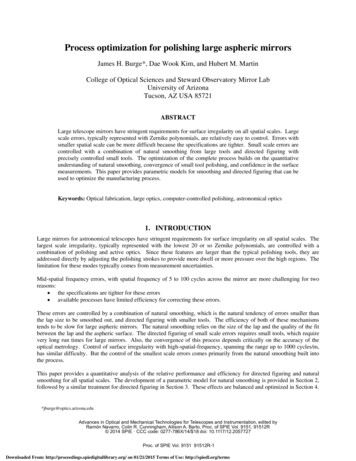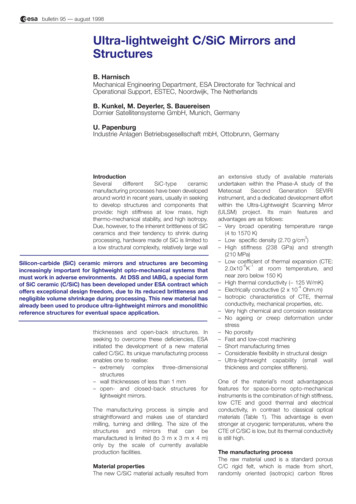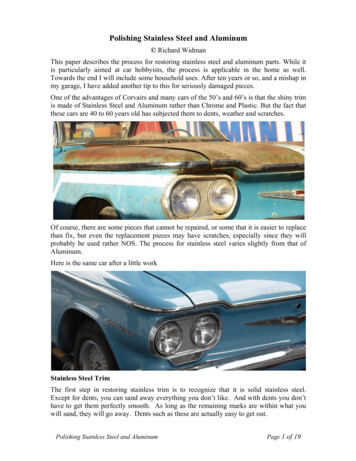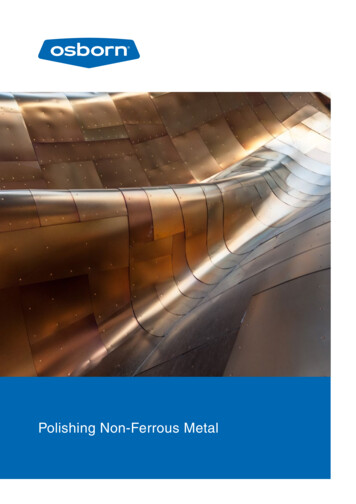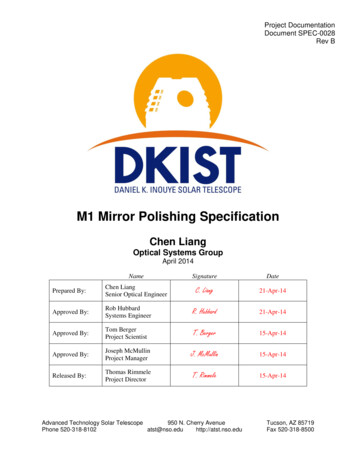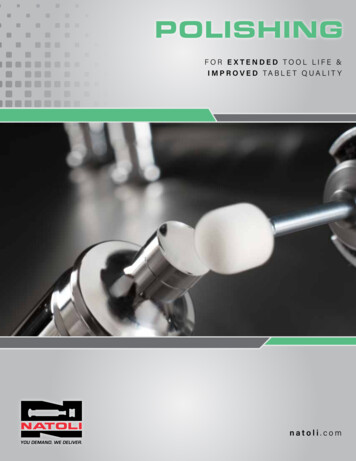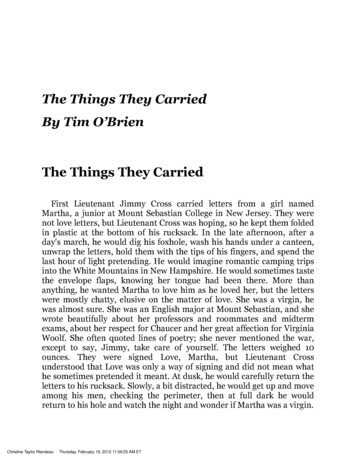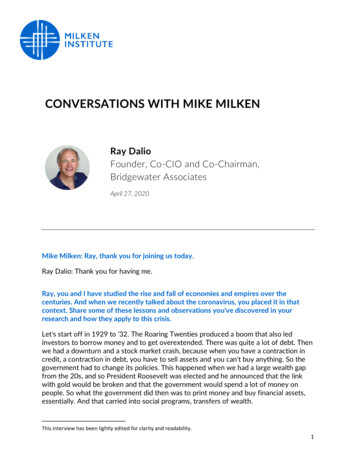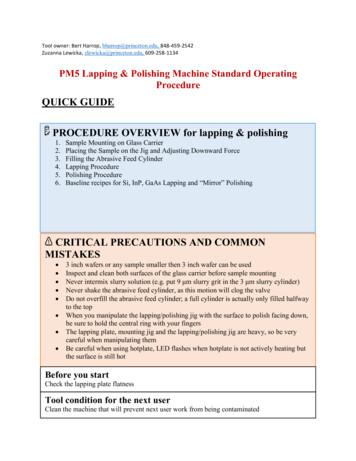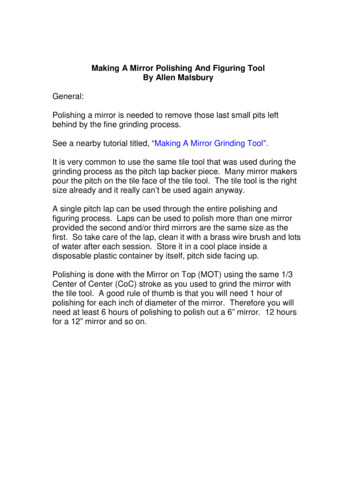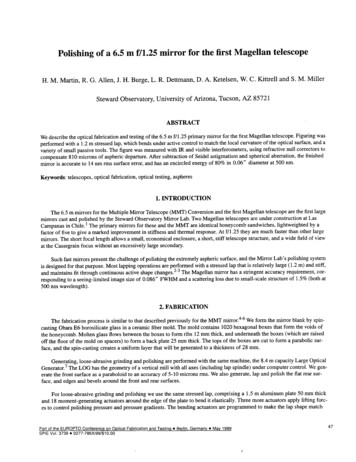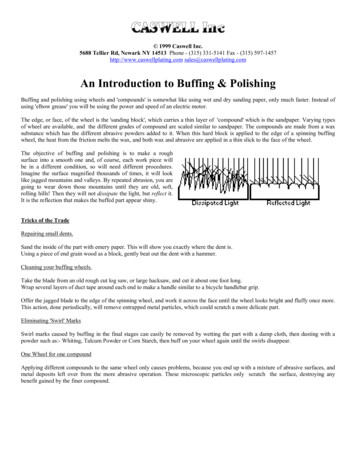
Transcription
CASWELL Inc 1999 Caswell Inc.5688 Tellier Rd, Newark NY 14513 Phone - (315) 331-5141 Fax - (315) 597-1457http://www.caswellplating.com sales@caswellplating.comAn Introduction to Buffing & PolishingBuffing and polishing using wheels and 'compounds' is somewhat like using wet and dry sanding paper, only much faster. Instead ofusing 'elbow grease' you will be using the power and speed of an electric motor.The edge, or face, of the wheel is the 'sanding block', which carries a thin layer of 'compound' which is the sandpaper. Varying typesof wheel are available, and the different grades of compound are scaled similar to sandpaper. The compounds are made from a waxsubstance which has the different abrasive powders added to it. When this hard block is applied to the edge of a spinning buffingwheel, the heat from the friction melts the wax, and both wax and abrasive are applied in a thin slick to the face of the wheel.The objective of buffing and polishing is to make a roughsurface into a smooth one and, of course, each work piece willbe in a different condition, so will need different procedures.Imagine the surface magnified thousands of times, it will looklike jagged mountains and valleys. By repeated abrasion, you aregoing to wear down those mountains until they are old, soft,rolling hills! Then they will not dissipate the light, but reflect it.It is the reflection that makes the buffed part appear shiny.Tricks of the TradeRepairing small dents.Sand the inside of the part with emery paper. This will show you exactly where the dent is.Using a piece of end grain wood as a block, gently beat out the dent with a hammer.Cleaning your buffing wheels.Take the blade from an old rough cut log saw, or large hacksaw, and cut it about one foot long.Wrap several layers of duct tape around each end to make a handle similar to a bicycle handlebar grip.Offer the jagged blade to the edge of the spinning wheel, and work it across the face until the wheel looks bright and fluffy once more.This action, done periodically, will remove entrapped metal particles, which could scratch a more delicate part.Eliminating 'Swirl' MarksSwirl marks caused by buffing in the final stages can easily be removed by wetting the part with a damp cloth, then dusting with apowder such as:- Whiting, Talcum Powder or Corn Starch, then buff on your wheel again until the swirls disappear.One Wheel for one compoundApplying different compounds to the same wheel only causes problems, because you end up with a mixture of abrasive surfaces, andmetal deposits left over from the more abrasive operation. These microscopic particles only scratch the surface, destroying anybenefit gained by the finer compound.
THE BRIGHTEX WHEELBrightex wheels are constructed from a type of material, impregnated with a fine abrasive powder. The resulting combination beingvery flexible, yet very aggressive.Brightex wheels remove rust, paint, scratches, minor blemishes and old paint.A 'featherlite' touch is required with these wheels, unlike an ordinary buffing wheel. Heavy pressure willresult in premature wear of the wheel.The blisters found in chrome plate, particularly on pot metal, can be flattened with this wheel. Substratestake on a satin or flat finish, which should then be buffed with Emery and a Sisal wheel, followed byWhite or Tripoli on a cotton wheel.THE SISAL BUFFING WHEELSisal is a slender, hard, cellular strand of fiber that has demonstratedgreat strength and tough resiliency in the form of binder twine, cord & rope for many years. Thesequalities, along with its natural abrading and grease absorbing characteristics, provide an idealbuffing wheel fabric.itsSisal buffing wheels will provide both polishing and cutting action. They will remove stretcherstrains, orange peel, polishing wheel grit lines, light die marks, etc.To effect a fast cut, use a sisal wheel with the Black Emery compound or any of the greaselesscompounds.THE SPIRAL SEWN WHEELSpiral sewn wheels are the workhorse of most buffing and polishing jobs. Because the ply's of cottoncloth are sewn together spirally, the wheel becomes much harder and more pressure can be exerted on it.This is especially useful when 'cutting' the metal. The faces of these wheels are pre-raked to acceptcompound immediately.These wheels are dependable and long wearing.THE LOOSE COTTON WHEELThe main purpose of a loose cotton wheel is to polish and cut in a similar manner to the Spiral sewnwheel, except that this wheel, not being tightly stitched together, will 'mush' or collapse, allowing thecotton to get into awkward places more easily. If you have an object with fine details and awkwardcrevices, then this is the wheel to use.THE CANTON FLANNEL WHEELCanton flannel is very soft, and this wheel is loosely stitched, so the layers of cloth flare out to give awide angle ultra smooth polishing surface.Generally used with the BLUE compound, this wheel can be used on the most delicate items such assilver and gold plate. This wheel should not be contaminated with any other compound.The actualcompound does the work, not the buffing wheel.
ABRASIVE NYLON WHEELSStrands of nylon impregnated with a tough aluminum oxide abrasive. Removes old paint, rust, weld scaleand burns. Cleans and polishes. Is ideal for wood because it cleans without gouging. It never loses itsabrasive power, or its shape. Safe on skin! Max 2500 rpmGenerally speaking, you will start off with a course abrasive compound, then change to a mediumcompound and finally a fine compound, just as you would using sandpaper.THE FINGER BUFFAn aggressive wheel, designed to buff irregular contoured metals, especially useful for buffing of checkerplate.The treated sewn cloth fingers penetrate into crevices etc. and at the same time reduce friction heat buildup,so reduces the possibility of distorting thin metal panels etc.Use with Greaseless or black emery compoundsThe wheel comes with a 5/8” hole in the metal center. ½” inserts are available.Fits the Caswell Buffer/Polisher for ultra fast buffing of large surface areas, such as RV’s, boats, trailers,trucks, etc.SISAL ROPE BUFFWith a thickness of 2”, this long lasting wheel is an economic alternative to stacking sisal wheels on a shaft.The fibers are treated and stiff, giving an excellent hard surface for the initial cut to de-burr etc.Use with Greaseless compounds or Black EmeryMUSHROOM BOBDiameter is approx. 3.5 inches. Ideal for buffing contoured shapes such as wheels. Use with anycompound on a drill or flexible shaft.FACER BOBDiameter is approx 2 inches. Ideal for buffing the flatter areas, especially wheels. Use with any compound.Good for using greaseless for removing cast casting marks in aluminum.
FLEXIBLE SHAFT GRINDERThis versatile tool is ideal for intricate work when hand grinding, drilling, deburring, buffing and polishing.With a choice of chucks, the smaller felt bobs with 1/8" shafts can be used for intricate work such asjewelry, and the 1/4" chuck allows the use of the larger bobs and buffing wheels, making it ideal for treatinglarger items such as aluminum wheels.The chuck has a protective cowl, preventing the chuck gearing from damaging any work piece.The foot pedal gives complete control of starting, stopping and speed.ABRASIVE WHEEL SYSTEMLOW COST FLEXIBLE GRINDING WHEELFor use on your buffing machine! This system is much more abrasive than the toughest greaselesscompounds. Cuts through: PAINT, RUST, PLATING Grinds away: SHARP EDGES, PITS,SCRATCHES, PARTING LINES, MOLD MARKS, TOOL & DIE MARKS, STRETCHED METALMARKS, BURRS ETC. The Abrasive Wheel System comprises of a special adhesive, and a toughaluminum oxide powder.One the adhesive has hardened on the wheel of your choice, (usually a spiral sewn buffing wheel) thewheel is transformed into a tough, yet somewhat flexible grinding wheel, capable of grinding of plating,paint, rust, and smoothing out all metals.The system is ideal for making felt bobs more abrasive.Using a knife or spatula, the thixotropic adhesive isspread evenly around the face of your wheel.Finally, roll the wheel into the abrasive using lightpressure, ensuring a heavy pickup of the abrasive.Leave the coated wheel to air dry for several hoursprior to use. Subsequent applications will provide alonger lasting system. Gentle heat from an oven willspeed up drying times considerably.As the system wears off, the wheel may be retreatednumerous times.
FLAP WHEELSThese tightly packed and bonded sheets of resin bonded aluminum oxide are great for sanding, shaping and polishing all types of materials.Especially good for removing paint and rust. Best used on an electric drill or the Flexibleshaft.SANDING DRUMSSanding drums are self expanding rubber spindles with hardened metalarbors and nuts.Precision manufactured to close tolerance, providing smooth and evenperformance.Use for: sanding, shaping, grinding, finishing, polishingUse on: wood, metal, plastic, fiberglass, rubber, glass or stone.Use with: portable drill or grinder, drill press, lather, flexible shaft, benchgrinder.Especially useful for surfaces that are curved or irregularly shaped.THE 3/4HP BUFFING MACHINEThis machine has the shaft extended out much further than one would normally find on a benchgrinder. This extension allows large items to be buffed without knocking the motor housing.The motor can be bench mounted or mounted to the optional stand, which MUST be boltedsecurely to the floor prior to operation.The 1/3rd HP BUFFING MACHINEThis sized motor runs 4” and 6” wheels and is ideal for buffing and polishingsmaller parts.It can be bench or stand mounted.
POLISHINGOnce the metal part has been buffed and polished, it is always advisable toprotect the shine with a wax or seal of some type.Collinite Metal Wax is ideal for sealing most metals, especially chrome plateditems.Other metals may need different treatments, such as aluminum cylinder headsmay need to be sprayed with VHT Clear and then baked to cure the coating.Aluminum side covers, not subjected to great heat can be sprayed with VHTClear Lacquer. This product does not have to be baked on.Most paint finishes are going to be waxed and then polished. To wax these surfaces, first wash the vehicle with a good detergent,ensuring all bugs and tar splashes etc. are removed. To assist in this, use Collinite Pre-Wax Cleaner.Apply your choice of Collinite Wax with a soft rag, and allow to dry. Then buff the area by hand or using the Buffer-Polisher.HAND HELD BUFFER – POLISHER - TWO MACHINES IN ONE!Our new Buffer-polisher is ideal to apply waxes to paint finishes AND to buff chrome and aluminum to a mirror shine.BUFFINGUse as a portable buffing machine -take it to the work piece.Set up the machine with regular buffing wheels. The shaft will takeone ½” thick wheel, up to 8” diameter.Here, the buffer-polisher is mounted with an 8" spiral sewnThe machine could also be clamped into a bench vise, to use as an ordinary buffer.Ideal for buffing bumpers, RV siding, truck fuel tanks, boat metal work, etc. etc.cottonwheel.POLISHINGChange the buffing wheels for the wool polishing bonnet, and use to polish up our Colliniterange of waxes.Use one bonnet for 'Color-up Cleaner', and the other to polish the wax.Now the buffer can be taken to the job, making light work of bumpers, checker-plate, andlarge metal areas.Supplied with sisal wheels, for cutting, spiral sewn cotton wheels forpolishing, and loose cotton wheels for that high quality final finish.BENCH MANDRELLS are an inexpensive way ofmaking up a special buffing machine. The shaft ends are ½” diameter are left and right handthreaded. The Chuck adapter can also be screwed onto one end of the mandrel, allowing theoperator to attach flap wheels, sanding drums and felt bobs.Ideally, a ½ -1hp 3450rpm motor is best suited for this job.
GLASS POLISHING KITNow With Optical Grade Cerium PowderA low cost solution to those irritating vision impairing scratchesOur glass polishing kit comprises one 2" diameter felt bob mounted on a 1/4" shaft, with a tub of abrasive optical grade Ceriumpowder. The finest glass polishing compound available.To remove scratches that you cannot feel with your fingernail, mark them on the inside of the glass with a crayon or a piece of tape.(Deeper scratches may not be possible to completely remove.)Mix up a small quantity of the abrasive powder with some water to make a wet slurry, and dip the flat end of the felt bob in it.Mount the bob in the fastest electric drill available.Using the FLAT bottom of the bob, (not the cylindrical side), work the slurry up and down across the scratch until it is removed.Keep the surface wet - do not allow the slurry to dry out, otherwise the glass will get hot. This is best accomplished by lightly sprayingthe glass with water from an old Windex spray container.Wheel RakeOur wheel rakes work really effectively to fluff up andremove debris from buffing wheels. Offer the jaggedblade to the edge of the spinning wheel, and work itacross the face until the wheel looks bright and fluffyonce more. This action, done periodically, will removeentrapped metal particles, which could scratch a moredelicate part. Or take the blade from an old rough cutlog saw, or large hacksaw, and cut it about one foot long. Wrap several layers of duct tape around each end to make a handle similar toa bicycle handlebar grip.
CHOOSING THE RIGHT WHEELThere are different types of wheels and these have differenteffects on the compound they are used with. For example, theSISAL wheel is a course 'rope like' fiber, which frays out tomake a sort of brush. These fibers have a very beneficial effecton scratched and rougher surfaces, almost stroking themsmooth. When used with a course 'EMERY' compound, they'cut' the metal down very rapidly. You could use thiscompound on a SPIRAL SEWN wheel and it would work, butthe job would take much longer because the softer SPIRALSEWN wheel is not going to thrash the metal so aggressively.Motor Size4"6"8"10"1/6 hp1".5"--1/4 hp1.5"1".5"-1/3 hp2.5"2"1"-1/2 hp3"2.5"2"1"3/4 hp4.5"3.5"2.5"2"As you progress through the buffing compounds, you will change your buffing wheel, ending up using the softest polishing wheel, theCANTON FLANNEL with the least abrasive BLUE or RED compound which only polishes, it has no cutting action.So, depending on the job in hand, you will determine which abrasive compound and wheel you are going to use first, then step downthrough the stages until YOU are satisfied with the results.Compounds are made from a mixture of fine abrasive fillers and a sort of greasy wax. The compound is melted, by friction heat, asthe bar is pressed to the revolving wheel. This applies a thin layer of abrasive, 'glued' onto the cloth wheel, making it similar to anemery paper, only much faster!Do not apply the compound after the workpiece, or on its own. This wastes material and is much less efficient.By applying the material before the workpiece, you actually use the workpiece to force the compound into the buff. This is much lesswasteful, more efficient and will actually speed up your buffing times.Apply small quantities of compound, by approx. 1/2 - 1 second applications to the wheel.When buffing plastics, it is preferable to use a loose cotton wheel and blue compound, but at a slower rate than normal. An oldwashing machine motor (1/8hp @ 1800 rpm) is ideal as the slower rpm lessens the chance of burning or melting the plastic.CUT AND POLISH MOTIONSThere are two basic buffing motions you should use.1. CUT MOTION gives you:SMOOTH SURFACE, SEMI-BRIGHT & UNIFORMThe workpiece should be moved AGAINST the direction of the wheel, using a MEDIUM toHARD pressure.2. COLOR MOTION gives you:BRIGHT, SHINY & CLEAN SURFACEThe workpiece should be moved TOWARD the direction of the wheel, using a MEDIUMLIGHT pressure.to
BUFFING SPEED AND PRESSUREThe correct pressure must be applied to the workpiece to provide the best finish economically and safely.Inadequate pressure will give NO buffing actionExcessive pressure will cause the buffing wheel to slow down or actually collapse. This can also result in burn marks on theworkpiece.BUFF RUNNING SPEEDSFor best results your wheel should maintain a surface speed of between 3600 & 7500 Surface Feet Per Minute. (SFPM). The higheryour speed, the better and quicker your results.Formula for calculating surface speed of wheel in SFPM.SFPM 1/4 x diameter of Wheel x RPM (revs of spindle per min.)Therefore an 8" wheel @ 3600 RPM 2 x 3600 7200SFPM.Spindle speeds can be increased by a step pulley on a motor shaft.For the workshop where only the occasional piece of work needs to be buffed, aneconomic alternative to purchasing a special machine is to simply adapt a benchgrinder. Whilst this does not have the extended shaft, it can still do a formidable job.All the guards need to be taken off and the grinder mounted on the edge of a workbench. This will allow access to the wheel frommany angles.Alternatively, a small used washing machine motor can be used. With access to a lathe, a simple pointed taper can be made to fit overthe shaft. Then the buffing wheels can be rammed on to the point. On smaller pieces, an electric drill with one of our shank mountedbuffs will do an excellent job.Some of our customers have even placed a large hand grinder in a vice, then changed the grinding wheel for a buff. These machinesusually have very high speeds with good power, so they should be considered as another option.Whenever you are making up something to do a buffing job, your prime consideration should be your safety.If the buff pulls the piece from your hands, you should consider where it is likely to go. Remember it will be traveling at a fair speed,so no one should be in its way!Is the machine mounted safely? It will have to stand a fair amount of abuse, so make sure it is WELL fastened down.DISCLAIMER - Buffing machines can be dangerous. We accept no liability for their use/misuse or for accidents caused by theremoval of guards.SAFETY FIRSTThere are two distinct areas on a buffing wheel THE UNSAFE AREA which is rotating towards theworkpiece.THE SAFE AREA which is rotating away from theworkpiece.The division of these two areas is marked with thedotted line on the above drawings.The workpiece must only be applied to the area of the buff that is rotating AWAY from the workpiece.
You should ensure that you are completely aware which area is which, otherwise you could have a serious accident. Objects beingthrown away from a buffing wheel can be traveling at very high speeds, which can result in some very unpleasant and potentiallydeadly accidents!When buffing parts have sharp corners, edges or hooks, they should be offered to the wheel with the edge flowing away from the buff,so the part does not catch.Operators should ALWAYS wear SAFETY GOGGLES, APRON and GLOVES.DETERMINING GRIT SIZES of SANDPAPERS and BUFFING COMPOUNDSWe often get asked, ‘Which grit should I use first?” Unfortunately, there is no cut and dried answer to this, because it really dependson the condition of the part. So, lets discuss some examples:1 Aluminum Side Cover with one deep scratch.To successfully remove the scratch, ALL of the material around the scratch has to bedisposed of. In our example, this means a lot of aluminum! Initially, we are concerned withgetting as much aluminum sanded off as quickly as possible, so we would use the coarsestabrasive available, say a 40 grit sandpaper.on a flat block. It would be of NO USE to try to buff out this deep scratch with a buffingwheel, because the wheel would remove more material from the hole, as well as the surrounding areas.By keeping the abrasive on a flat block, no further material can be removed from the hole.As the scratch is lessened, the grit size of paper is reduced from 40, to 80, 120, 240, 320 andfinally 600.Once the surrounding material is removed, then the actual polishing can bestarted.Buffing compounds will be determined by the size of the scratches. If you have used a 600 grit paper, you may like to proceed directlyto a white buffing compound. If fine scratches are visible, then you’ll need to ‘back off’ and go to the black compound before retryingthe white.2. Aluminum Side Cover - just dull.Obviously, it would be a step backwards to start treating this piece by using the technique in our first example. As there is no largemetal content to be removed, you could virtually dispense with the sandpapers and move directly to the polishing aspect of the part.The Brown buffing compound with a spiral sewn wheel could be employed to see if the shine is good enough. If not, then use a blackcompound, and then rework the part using the brown compound.3. Aluminum Wheel Casting.Many wheels are prepainted, directly over a rough sand casting. Remove the paint using BUSCH Clearcoat Remover, to expose thealuminum. The ‘pimples’ caused by the sand cast have to be removed to flatten the metal ready for polishing. Because of the difficultcontours of the wheel, it is virtually impossible to sand with a flat block, so this is where Greaseless Compound comes in. Start offwith the 80 grit, using a spiral sewn wheel or, for the awkward areas, a felt bob. Then proceed through the various grit sizes ofGreaseless, until the metal is smooth , all ‘pimples’ are removed and an even ‘flat’ finish is achieved. The polishing should only beginonce all traces of ‘pimples’ are gone. Use Black Compound for most of the polishing work, and finally, on a fresh or cleaned wheel,buff lightly with the Brown compound.
PlasticsBuff TypeSisalSpiral SewnLooseCanton CSilver, Gold (plated andsolid) and very thinplatesABCNickel and ChromePlateABCXXXXCopper, Brass,Aluminum, Pot Metaland Other Soft MetalsABCXXXSteel and IronAXBStainless SteelCAXXBCXXXXXXXXXXXXXXXXXXXXXXBLACK Emery Compound, a course abrasive material for removal of scratches, pits, paint, rust etc.BROWN Tripoli compound used for general purpose cut and color on most soft metals.WHITE Blizzard compound, used for color and final finish of harder metals, has a cuttingaction.RED Jeweller's Rouge, designed to polish without any cutting action. Safe on thin plates. Use onits own wheel.BLUE A dryer, almost greaseless wheel - designed to polish without any cutting action. Safe onthin plates. Use on its own wheel.GREEN Used exclusively for Stainless Steel.THE THREE BUFFING STAGESA Rough Cut To Remove ScratchesB Final Cut & Initial Polish*C Final Polish (or luster)* - At Stage B, you should first use your wheel with a cuttingaction, then finish with a color action. See the page on Cut &Color.X
POLISHING Change the buffing wheels for the wool polishing bonnet, and use to polish up our Collinite range of waxes. Use one bonnet for 'Color-up Cleaner', and the other to polish the wax. Now t
